Let’s jump back to July 27, his feast day.
Panteleimon, the Great Martyr and Unmercenary Healer
How to pronounce Παντελεήμων? Not easy unless you’re Greek. Say “Pahn teh LEH-EE mohn” a few times slowly, and you’ll probably have it. It means “all merciful”.
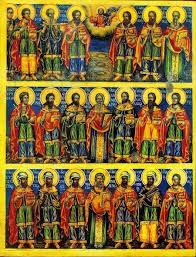 A “Great Martyr” (Μεγαλομάρτυς) is a martyr who has undergone dreadul tortures, has performed many miracles and is now venerated throughout the Church. (I had to look this up. I wasn’t sure.)
A “Great Martyr” (Μεγαλομάρτυς) is a martyr who has undergone dreadul tortures, has performed many miracles and is now venerated throughout the Church. (I had to look this up. I wasn’t sure.)
“Unmercenary” is from αναργύρος, literally meaning “no silver”. The Orthodox Church has a whole category of “Unmercenary Physicians”. Left “How much do I owe you, doctor?” “Nothing.” “What?!” “Just go home and thank God.” They healed using both God-given medical arts and also Christ’s miraculous power – the proper combination of “science”and “religion”.
How I met Saint Panteleimon
I knew he is significant, since he is commemorated by name so many places: In the Proskimidi before Divine Liturgy. At Holy Unction he has his own Troparion, as part of a very “elite” group: the Theotokos, the Apostle John, James the Lord’s Brother, Nicholas, Demetrios – and Panteleimon. He is invoked at Holy Unction, at the Blessing of Water, and in other Prayers for the Sick.
But I hadn’t paid him much attention until the year 2011. I had gone again to Greece, staying on the south coast of Crete till Khouria Dianna would join me. Somehow I discovered that Nick and Elizabeth, a young Orthodox couple I knew well (had assisted at their wedding), would be on Crete, departing from the airport in Heraklion just one hour before my wife was to arrive at that same place! This was so quirky it felt like God or Saint Nektarios or somebody had arranged it.
So I drove over the mountain as soon I could see the road (guardrails on the edge of cliffs in rural Greece? ha!) and picked them up at their hotel. We went to Divine Liturgy at the Cathedral, got proino, and went exploring. After we saw the 4000 year old Minoan city Knossos, I wanted to show them a monastery atop a hill west of Heraklion but just could not find the road, so we drove on west for a while. We were just about to head back when Nick spotted a sign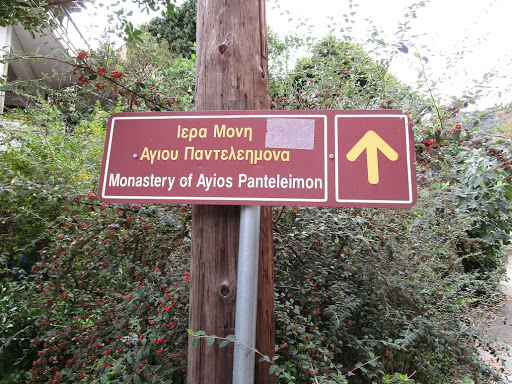 : “Μονή Αγίου Παντελεήμονος”. right He said, Let’s go there. So we did.
: “Μονή Αγίου Παντελεήμονος”. right He said, Let’s go there. So we did.
A good rather busy road took us to a village, after which the road narrowed and got rougher and busier, after which the road became narrow and gravelly and still busier. What ever was going on? We soon came to this small monastery. below Cars were parked up and down the road and  all about. Many families were having picnics, their kids running around. And there was a line waiting to enter the monastery church. We went in.
all about. Many families were having picnics, their kids running around. And there was a line waiting to enter the monastery church. We went in.
There people were going forward to venerate something in a roundish silver container. 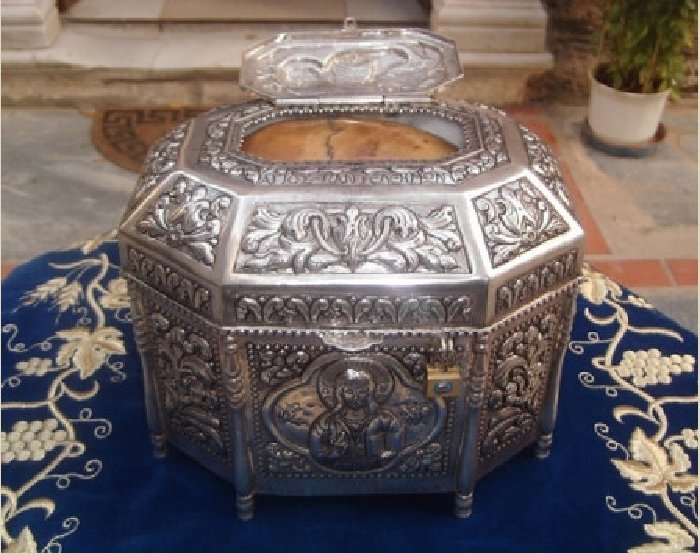 Elizabeth asked: What’s that? I said: I think it’s somebody’s head. She asked: Whose, do you suppose? I said (drawing on my accumulated wisdom): We’ll never know; nobody will speak English back here. So she walked over and asked a monk, who responded in perfect English (!): It’s the skull of Saint Panteleimon. He’s visiting today.
Elizabeth asked: What’s that? I said: I think it’s somebody’s head. She asked: Whose, do you suppose? I said (drawing on my accumulated wisdom): We’ll never know; nobody will speak English back here. So she walked over and asked a monk, who responded in perfect English (!): It’s the skull of Saint Panteleimon. He’s visiting today.
Saint Panteleimon’s skull normally resides at Palachantrou Monastery left 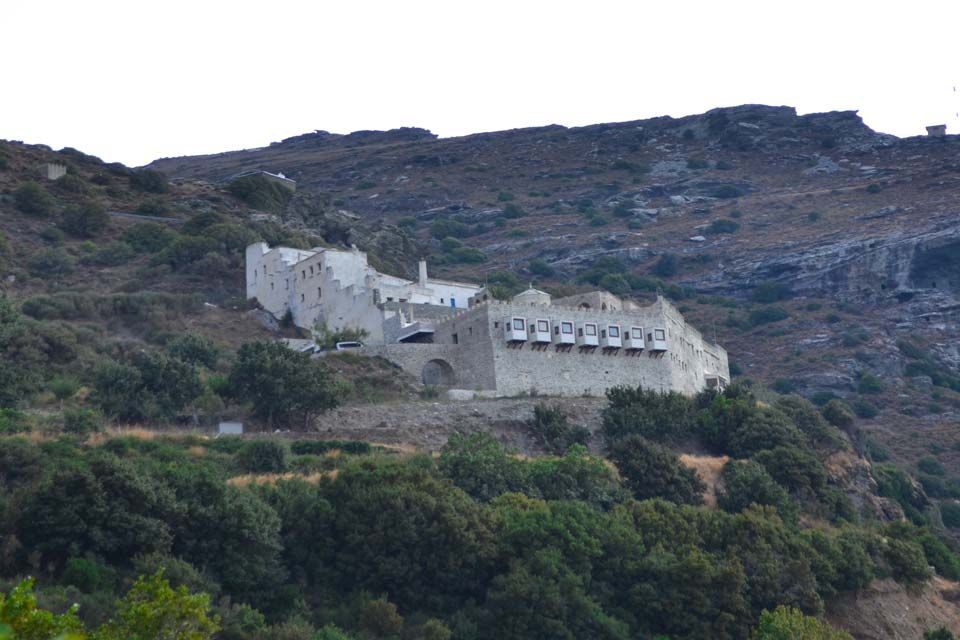 on the island of Andros, out in the Aegean, but he was now “making the rounds” of various churches and monasteries, as major Orthodox relics sometimes do. And today he was here, and so were we!
on the island of Andros, out in the Aegean, but he was now “making the rounds” of various churches and monasteries, as major Orthodox relics sometimes do. And today he was here, and so were we!
So we went up and kissed the container with his head in it, said a few prayers and hurried back to Heraklion, so they could catch their plane. We were rather in awe – that we entirely by chance (?) should drive down a back road to a monastery we’d never heard of, and there was a major Greek saint waiting for us! I mean, what were the chances? To cap it off, my wife’s plane arrived exactly on time. The whole day felt like a sort of blessed “set up”, so to speak.
Since then I’ve called often on Saint Panteleimon.
But I never really knew much about him – till I prepared this Post.
About Venerating Relics
Before I was Orthodox, honoring relics of saints seemed weird. And venerating somebody’s skull? Well… ! That was then. This is now. Now it’s entirely natural. Someone said that Christianity is the most “material” religion in the world – because God was Incarnate, “enfleshed”. And Orthodoxy is the most “physical” kind of Christianity. Just watch us.
Everyone values “secondary relics” of departed love ones. My mother’s cut glass plates, the recording of my parents’ voices, recovered after I hadn’t heard them for decades. Their pictures. How I treasure these things!
Most Christians honor the places where our loved ones’ bodies are buried. We Orthodox often take it further. One time I skipped out on a church conference (don’t tell my bishop), drove fifty miles south, got a sandwich and a Coke, took them to my parents’ grave and had lunch with them. I felt so close to them. Pagan practice? No. Orthodox.
Unless people are known to be saints, we don’t hang onto their bones. But we have open caskets at funerals. Before we close the casket I kiss peoples’ foreheads or at least pat their hands. When Deacon Ignatius and I vested Deacon John for burial, I was so sad I could hardly do it, but it felt natural. Before I was Orthodox these things would have given me the creeps. That was then.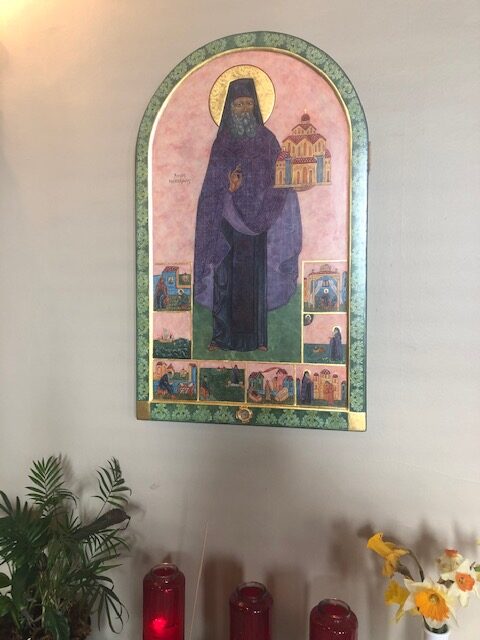
Now… magnify this many-fold for a saint, through whose bones God works miracles. We share with Roman Catholics the practice of distributing their relics (small pieces of their bones) throughout the world. At Saint Nicholas, Cedarburg, we have a relic from Saint Nicholas in our Altar table, and a relic of Saint Nektarios embedded at the bottom of his icon. Left. Sorry, the picture could be better. Whether we experience their miracles or not (with these two I have) this connects us physically with these blessed men and women.
But why do we venerate Saint Panteleimon’s skull, separate from his body? Because was beheaded, that’s why. We’re coming to that.
Why do certain saints become so popular?
I mean, they’ve had no TV commercials: “Turn to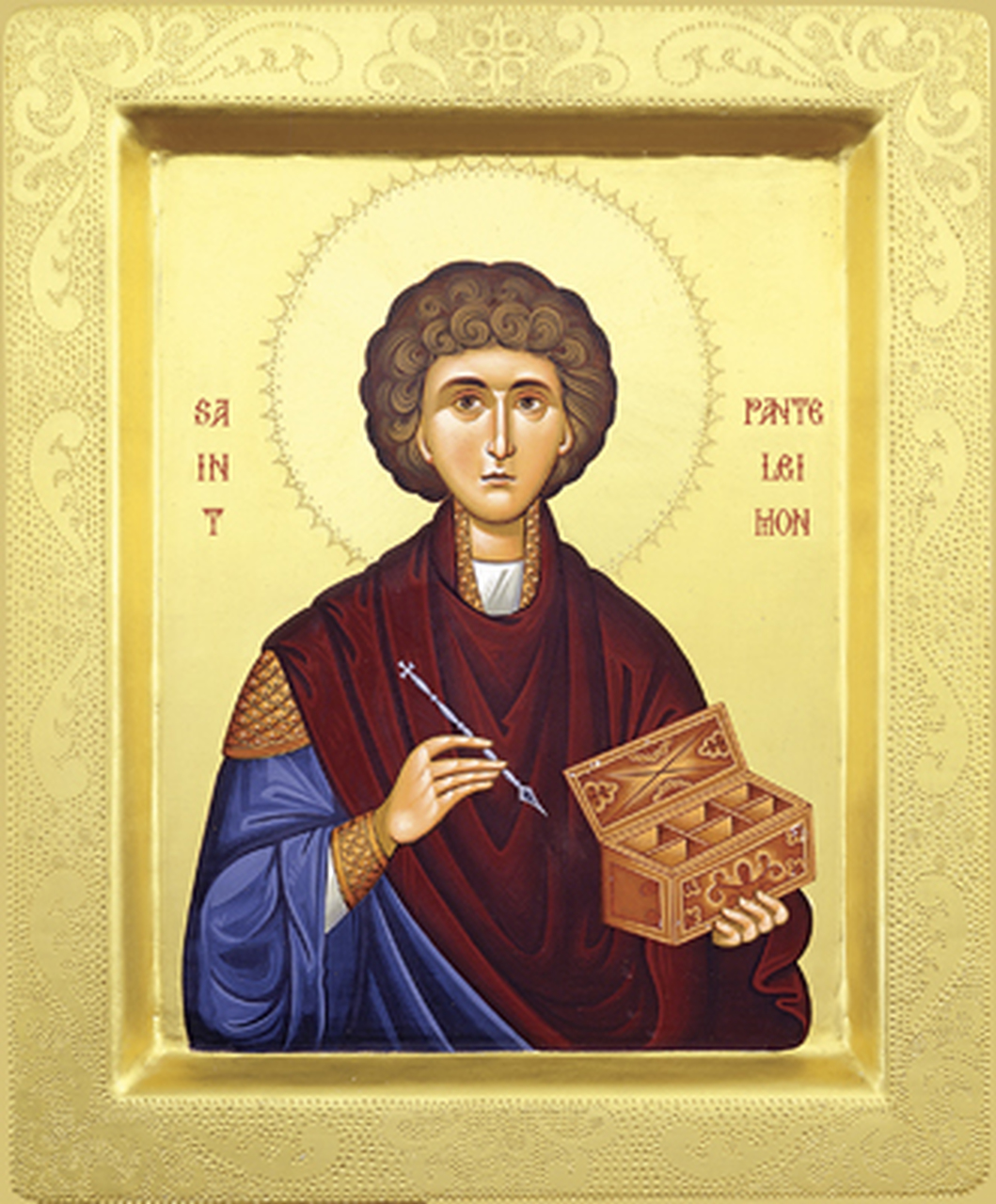 Saint X, the most powerful saint you can use for your backache”, or whatever. So why, of all the martyrs of the early centuries, are a few like Saint Panteleimon still so venerated?
Saint X, the most powerful saint you can use for your backache”, or whatever. So why, of all the martyrs of the early centuries, are a few like Saint Panteleimon still so venerated?
Two answers:
1 Miracles and remarkable events connected with them. Sometimes it sounds like miracles were everyday occurrences in the old days. They were not. They were (and are) very rare, amazing, inexplicable events. That’s why they were (and are) remembered.
2 Their life stories. Panteleimon, a handsome young doctor who served the needy, cut down in the prime of his life because he refused to forsake his Lord Jesus Christ. Shocking. Compelling. Inspiring. Unforgettable. And then what came after that which was even more memorable.
The Life of Saint Panteleimon
Now, in the case of certain saints of the ancient world, we can wonder if their stories have been, um, “augmented” a bit, shall we say? Not here. Panteleimon’s story was recorded by his servants Laurence, Bassos and Probus who knew him and witnessed his martyrdom.
Panteleimon came from Nicomedia, born in the year 275 to a notable pagan father Eustorgius and a Christian mother Evoula. They named him “Pantaleon (“All Lion”). When he was a boy his mother died, so he was raised by his father. He was good looking (which never gets in the way) and brilliant – studied the sciences and medicine, becoming so skillful that the Emperor Maximian hoped to appoint him as royal physician. But before that could happen…
born in the year 275 to a notable pagan father Eustorgius and a Christian mother Evoula. They named him “Pantaleon (“All Lion”). When he was a boy his mother died, so he was raised by his father. He was good looking (which never gets in the way) and brilliant – studied the sciences and medicine, becoming so skillful that the Emperor Maximian hoped to appoint him as royal physician. But before that could happen…
At that time three priests (later hieromartyrs) Hermolaos, Hermippos and Hermocrates were living in hiding in Nicomedia – survivors of this same Maximian’s  massacre of many thousands of Christians. Left: Maximian. You get the picture. They called on Doctor Pantaleon to visit them several times. (Within my lifetime, physicians still made house calls.) One time they spoke to him about Christ. After that he began to visit every day.
massacre of many thousands of Christians. Left: Maximian. You get the picture. They called on Doctor Pantaleon to visit them several times. (Within my lifetime, physicians still made house calls.) One time they spoke to him about Christ. After that he began to visit every day.
On his way home one day Pantaleon found a child lying in the street dead, bitten by a great snake which was still curled up with the child. Pantaleon found himself praying to Christ: If He would restore the child and destroy the snake, he would be baptized. To his astonishment the child rose up, and the snake was dead!
Hermolaos 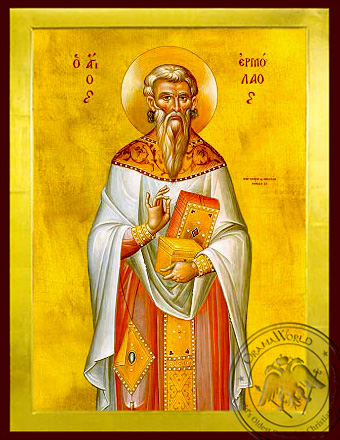 right baptized him and gave him the name Panteleimon. His father was amazed at what had happened, so Panteleimon told him about Christ, and soon he also became a Christian. Saint Panteleimon now dedicated his life to the sick and needy, especially Christian prisoners. He healed with a power beyond ordinary medicine, without charge. Accounts of this spread through the city, and soon many were abandoning their own doctors and flocking to this Christian healer. During time of persecution, this spelled trouble.
right baptized him and gave him the name Panteleimon. His father was amazed at what had happened, so Panteleimon told him about Christ, and soon he also became a Christian. Saint Panteleimon now dedicated his life to the sick and needy, especially Christian prisoners. He healed with a power beyond ordinary medicine, without charge. Accounts of this spread through the city, and soon many were abandoning their own doctors and flocking to this Christian healer. During time of persecution, this spelled trouble.
Envious doctors complained about Panteleimon to Emperor Maximian who began by commanding him to offer sacrifice to the idols. When he refused, Maximian decided to test him. He had an “incurably” paralyzed man brought in, and commanded Saint Panteleimon to pray to his God and heal him. He did so, and the man walked. But Maximian refused to accept the clear evidence (as rulers sometimes do), had the man executed (poor man – healed for a few hours, then killed) and gave Panteleimon over to torture.
Maximian decided to make a spectacle to show people what happens to Christians. He had Panteleimon tied to a tree and scraped with hooks, then burned with fire, then stretched on a rack, then thrown into boiling tar, finally cast into the sea with a stone ’round his neck.
Now, when we hear these stories of saints suffering a series of tortures, we needn’t think they happened in immediate succession. My guess is that when, over a period of time, the saints recovered by the healing power of God, and the authorities discovered it hadn’t worked, then 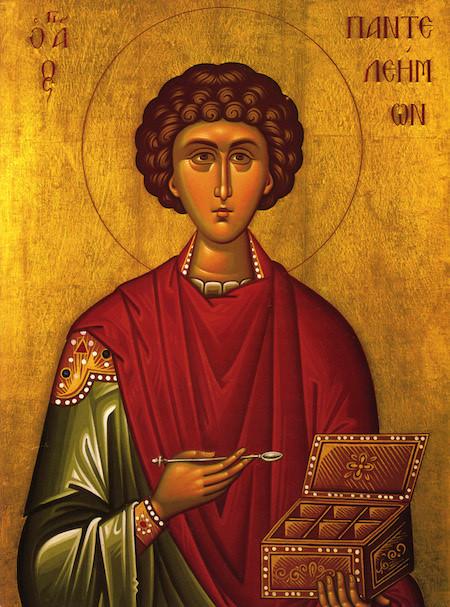 they proceeded to the next one.
they proceeded to the next one.
From all this Panteleimon recovered and refused to give in. He told his servants that, in their midst, Christ Himself had appeared to strengthen him.
Maximian was furious. He tried one more time. Panteleimon was taken into the arena to be devoured by wild beasts. When they (God bless them) came up and licked his feet, the crowd began to cry “Great is the God of the Christians!” The Emperor was losing the battle.
So he got it over quickly. He ordered Saint Panteleimon to be beheaded. When the soldiers refused, Panteleimon told them to obey the Emperor’s command. They fell down before the Holy Martyr, begged his forgiveness, kissed this Holy Man farewell, and did their duty. It was July 27, 305. He was thirty years old.
Maximian decided to destroy the evidence. He had Saint Panteleimon’s body thrown into a fire. Even that didn’t work. it remained untouched. Christians came and buried him. The tree to which he had been tied later blossomed and bore fruit.
Panteleimon’s tragic but glorious story became widely circulated. During time of persecution martyrs’ stories of this sort gave strength to the Church – as it survived persecution after persecution and was still alive. “The Church grew on the blood of the martyrs.”
And then: Miracles! Healings in Nicomedia, spreading through the Empire and beyond. They continue today. His relics are now all over the world.
He is revered especially in Greece and also in Russia, where he is called upon to heal soldiers wounded in battle and also aid those engaged in spiritual warfare.
Google “Saint Panteleimon Church”, and more will come up than you’ll want to count. Trip Advisor says Saint Panteleimon, Athens, left is a “must see”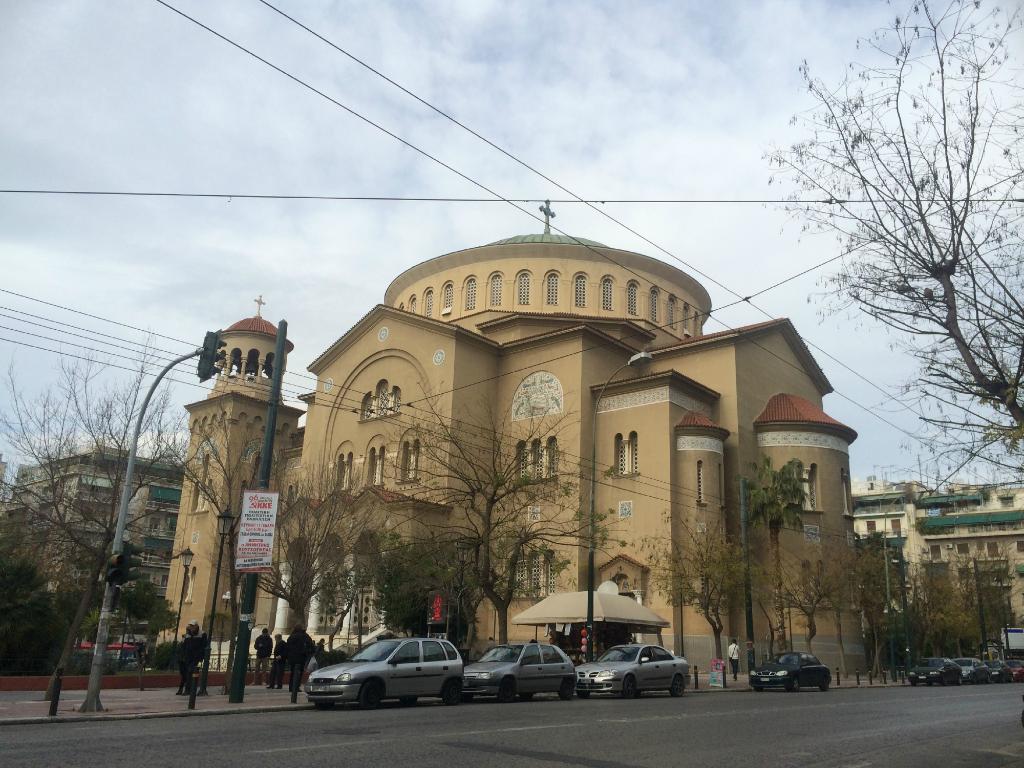 .
.
There are Saint Panteleimon Societies dedicated to Orthodox health care. For example: http://ww1.antiochian.org/st-panteleimon-fellowship-society-practice-orthodox-christian-healthcare
In the Roman Catholic Church he is honored under his given name Pantaleon.
in Italy, where saints sometimes seem to go a bit “off the rails”, there is a superstition that Pantaleon provides favorable lottery numbers! (Don’t ask.)
And also this. Follow closely. In Italy a popular form of his name was “Pantaloon”. For reasons never explained, Shakespeare, in his play “As You Like It”, took “Pantaloon” as the name for a man who wore knee breeches. This gave the name to a type of trousers called “pantaloons”, which was (can you see what’s coming?) later alterated to “pants”. So every time you pull on a pair of pants, say “Saint Panteleimon, pray for me”! Who would have guessed?
This is no place to stop. Let’s be serious again. 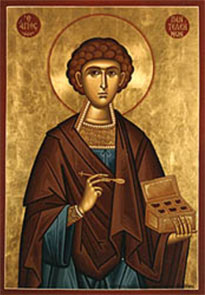
First Kontakion from the Akathist Hymn to Saint Panteleimon
Chosen passion-bearer of Christ and gracious healer, you freely grant healing to the sick. We praise you in songs as our protector. As you have boldness with the Lord, free us from all harm and sickness, who cry with love to you: Rejoice, Great Martyr and Healer Panteleimon!
Next Week: Slapstick in the Gospels?
Week after Next: What did Jesus look like?

For your smorgasboard. roman-emperors.org/maxherc.htm.
Maximianus a co emperor with Diocletian. He had as an assistant Constantius Chlorus who married his daughter. (Constantius Chlorus’ son was Constantine who became Emperor at Eboracum in Britannia .. now called York in England.)
Maximianus was Emperor in the West for a while at Mediolanum ( Milan) where he was asssociated with St Germanus, previously a Roman civil servant. Diocletian held the Eastern Empire with the capital at Nicaea.
Thank you.